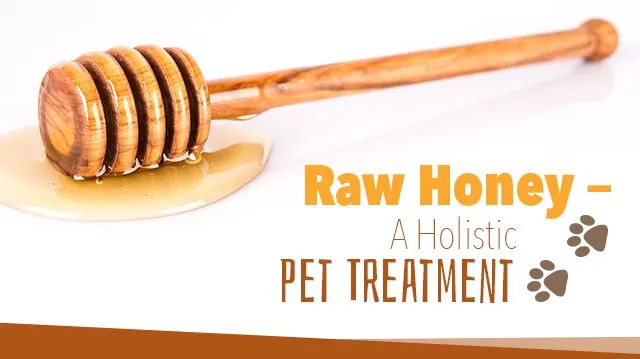
- Share on Facebook457
- Share on Pinterest
- Share on Twitter
Raw honey not only tastes great, but it has many medicinal benefits for humans and animals. The topical application is just as useful as ingesting it — and your pets love it too.
Raw honey
Processed honey doesn’t contain pollen, and it also lacks the nutrients found in raw honey. Pasteurization eradicates or severely limits honey’s health properties. The beneficial components of raw honey include:
- Antibacterial, antifungal and antimicrobial effects
- Antioxidants
- Natural enzymes
- Powerful nutrients
Processed honey may actually contain fungi or bacteria, so don’t substitute it for raw honey when using it as a treatment for you or your pet.
Manuka honey
Manuka honey, originating from New Zealand, is the raw honey par excellence for its antibacterial and other health properties. It’s also among the priciest. Bees pollinating the country’s indigenous manuka bushes create this remarkable honey, but there’s a problem of supply and demand. Frankly, demand far outstrips the supply of genuine manuka honey, so there’s honey on the market claiming to be Manuka that contains little or none of the real deal. When purchasing Manuka honey, look for the United Manuka Factor (UMF) Honey Association logo on the jar. A number on the black and yellow UMF logo indicates the honey’s grade.
Canine allergies
If your dog is scratching or suffers from frequent ear infections, he may suffer from allergies. You can alleviate allergic symptoms by giving your dog small amounts of raw honey daily. Rodale’s Organic Life recommends giving small dogs a few drops a day and working up to one-quarter of a teaspoon, while starting large dogs at one-quarter of a teaspoon and working up to a teaspoon per day. For best results, use local raw honey, as this honey contains pollen spores that may affect your pet. Slowly introducing the honey to your dog may help build up immunity to the irritant.
While raw honey may alleviate the symptoms, there may still be underlying allergies, so visit the vet to determine the cause. Common canine allergies include reactions to food, fleas and pollen.
Intestinal issues
Raw honey can aid pets dealing with intestinal issues, especially diarrhea. If your pet ate something that was disagreeable, a small amount of honey helps settle the stomach. If your pet lacks interest in food, a little honey and water helps the digestive tract heal. Of course, a dog or cat experiencing severe vomiting or diarrhea requires veterinary attention.
Wound care
Topical use of honey is messy, but it’s excellent for healing. If your pet has a wound or sore, dab some raw honey on it. Raw honey contains the enzyme glucose oxidase. This enzyme produces antibacterial hydrogen peroxide. Honey keeps the wound moist and reduces or eliminates swelling, odor and pus from infections. Wounds treated with honey not only heal more efficiently, but also result in less scar tissue.
Of course, you can’t allow your pet to lick the honey off the wound. Your pet may have to deal with an Elizabethan collar — the “cone of shame” — if it can reach the wound with its tongue.
You can also purchase medical grade honey created specifically for wound care at health stores and many general pharmacies, as well as online.
Honey for horses
Horse owners should always keep raw honey in their equine medicine chests. Horses are prone to finding new and creative ways to injure themselves, and raw honey can heal wounds when nothing else works.
In The Horse Magazine, veterinarian Dr. Ian Nielsen states that he has treated severe leg wounds successfully with honey. These wounds include degloving, where large amounts of skin are torn off the leg. In his field trials — which did not include controls — Nielsen found that healing time was cut in half, with much less pus and odor compared to conventional therapies. He also found less scarring than expected with such serious injuries. Equine leg wounds treated with honey require bandaging, and the horse should be confined while healing, according to Nielsen.
Part of his clinical trial involved two thoroughbred yearlings who badly damaged their legs in a horrific hailstorm. The owner wanted to euthanize them, but Nielsen persuaded the owner to let him try the honey regimen. Not only did the yearlings recover, but both went on to have successful racing careers.
—Jane Meggitt
Jane Meggitt graduated from New York University and worked as a staff writer for a major New Jersey newspaper chain. Her work on pets, equines and health have appeared in dozens of publications, including The Daily Puppy, The Nest Pets, Horse News, Hoof Beats and Horseback magazines.
Sources:
http://www.rodalesorganiclife.com/wellbeing/3-holistic-pet-cures-that-use-raw-honey
http://www.horsemagazine.com/thm/2015/02/trials-on-honey-treatment-for-leg-wounds-in-horses
http://naturalhorseworld.com/newsite/honey-for-healing-wounds
http://www.petmd.com/blogs/thedailyvet/aobriendvm/2014/february/honey-great-wound-care-but-not-all-honeys-are-equal-31340
http://drjeandoddspethealthresource.tumblr.com/post/58633442872/raw-honey-pets#.Vvs042XD8qQ
http://permaculturenews.org/2014/02/08/shocking-differences-raw-honey-processed-golden-honey-found-grocery-retailers
http://www.gaiahealthblog.com/2013/12/22/the-manuka-project
http://www.umf.org.nz
- Share on Facebook457
- Share on Pinterest
- Share on Twitter

